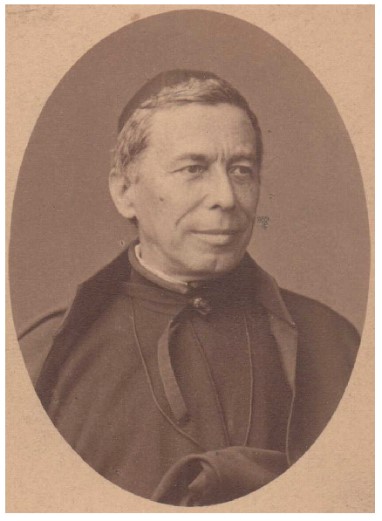This week has been full of late-day thunderstorms, which add drama to an afternoon in the lab but might also render that lab completely useless. When the electricity goes out, today’s grad student is left staring bleakly at the instrument that was surely about to return the data that would revolutionize her research. There is little to do in a darkened lab beyond washing glassware, and until you’ve spent a few hours doing just that, it’s hard to fully appreciate olden-day scientists who somehow managed to get stuff done without the benefit of switches and batteries. If you’re an aquatic scientist, you’ve probably used one of the most charmingly simple tools out there: the Secchi disk. It’s a pretty foolproof field instrument, but let’s be honest, you’ve been secretly wondering about its history, if for no other reason than to explain to giggling high school visitors that no, it’s not a sucky disk.
Father Pietro Angelo Secchi (1818-1878) is primarily remembered as an astrophysicist, a legacy that might surprise some readers given his religious title. After joining the Order of the Jesuits, Fr. Secchi showed great scientific aptitude that eventually landed him a position as a math and physics professor at Jesuit College in Loreto, Italy. His 1847 ordination as priest was terribly timed, as the Roman revolution of the following year necessitated that he flee the city. Fr. Secchi spent the next three years teaching in Britain and at Georgetown University in Washington, DC, where he became friends with Matthew Fontaine Maury, commonly nicknamed the Father of Oceanography. Their correspondence lasted throughout Maury’s life.
Upon returning to Rome in 1850, Fr. Secchi was named director of the Observatory of the Roman College, the precursor of the Vatican Observatory. (The rebooted Cosmos series has renewed talk about astronomy/religion, and the Vatican Observatory, incidentally, lends a very interesting angle to these discussions. How many people knew there were a bunch of Jesuits in Rome studying extragalactic astronomy and meteor density?) Fr. Secchi worked at the Observatory for the rest of his life, making discoveries that now overshadow his eponymous disk. He developed a spectral class system that served as the early basis for categorizing stars, proved that the sun was a star because the Earth’s atmosphere absorbed its light, and created an instrument known as a meteorgraph that recorded weather conditions.

The Secchi disk is a black-and-white disk used to measure water transparency. It’s lowered over the side of a boat until no longer visible, and the amount of rope released is recorded to determine water depth. The depth is then related to the cloudiness of the water. Image from http://pidjanga.blogspot.com/2006_09_01_archive.html.
By now, you’re probably falling off your chair in anticipation- what about the Secchi disk?? Well, since Fr. Secchi was one of the Pope’s scientific advisors, he was asked to design a way to quantify water transparency in the Mediterranean Sea. Sources say that on April 20, 1865, Fr. Secchi deployed the first Secchi disk from the papal yacht. There are two versions of the Secchi disk in use today- one is solid white and the other has black and white quadrants- and it appears that Fr. Secchi used the all-white model. Before all you science history purists rush off to buy white Secchi disks, though, it’s worth noting that an article by MW Wernand in the Journal of the European Optical Society stipulates that water transparency measurements predated Secchi, with the oldest recorded in 1676. However, Wernand explains that since Secchi was the first to standardize the procedure and, more importantly, the first to publish his results, the method bears his name to this day. In more ways than one, then, the Secchi disk illustrates that some things in science never change.
For more info:
Wernand MW. 2010. On the history of the Secchi disk. Journal of the European Optical Society. Rapid Publications 5- 10013S. http://www.jeos.org/index.php/jeos_rp/article/view/10013s
History of the Secchi disk: http://www.pca.state.mn.us/index.php/water/water-types-and-programs/surface-water/lakes/citizen-lake-monitoring-program/history-of-the-secchi-disk.html
Biography of Fr. Secchi: http://www.newadvent.org/cathen/13669a.htm
Vatican Observatory: http://vaticanobservatory.org/

Pingback: The Secchi Disk Celebrates 150 Years of Clarity | UW-Madison Center for Limnology